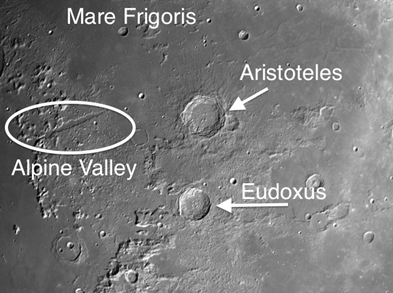The week of July 31 – August 6 takes us from Day 14 to Day 21. This week we will highlight the moon crater Eudoxus, viewable early Sunday morning before sunrise.
 Eudoxus: [NE/E11; L=16°E] Both Eudoxus and Aristoteles to its north are wonderfully complex craters with terraced walls. Look closely at the pair. It’s subtle, but can you see any features that would suggest which is older?1 Just to the northeast of Eudoxus are three simple craters. Can you tell if their floors are bowl-shaped or flat?
Eudoxus: [NE/E11; L=16°E] Both Eudoxus and Aristoteles to its north are wonderfully complex craters with terraced walls. Look closely at the pair. It’s subtle, but can you see any features that would suggest which is older?1 Just to the northeast of Eudoxus are three simple craters. Can you tell if their floors are bowl-shaped or flat?
OF ADDITIONAL INTEREST IN SPACE
The Delta Aquarid meteors will be visible Monday night.
On Thursday Saturn will be 2° north of the Moon.
1Eudoxus: (c. 410-350 BCE) Greek astronomer and student of Plato who created a system of 27 spheres to account for the movement of the celestial bodies. This Appendix A: Historical Notes model of the solar system, in various forms and modifications (most famously by Ptolemy) persisted until Copernicus in the 1500s.
======================
It is highly recommended that you get a copy of Sky and Telescope’s Field Map of the Moon, the very finest Moon map available for use at the telescope. It is available for $10.95 at www.skyandtelescope.com and on Amazon. All features mentioned in this blog will be keyed to the grid on the Field Map and will look like this: Plato: [NW/D9]
Credits:
Courtesy of Gray Photography of Corpus Christi, Texas
Lunar photos: NASA / USGS / BMDO / LROC / ASU / DLR / LOLA / Moon Globe. Used by permission
- Rupes Cauchy: A Best Known Fault on the Moon - July 22, 2024
- Moon Crater Schickard – Crater Floor has Stripes - July 15, 2024
- Moon Craters Langrenus and Vandelinus - July 8, 2024